Starting and running a small business in Kenya is no easy feat. You have the ideas, the vision, and the drive but what happens when you need extra capital to grow? Whether it’s stocking up on inventory, expanding your operations, or weathering unexpected financial challenges, getting an SME loan can be the key to unlocking success.
But let’s be honest navigating the world of business financing can feel overwhelming. Where do you start? Who do you borrow from? And what are the risks? This guide will take you through everything you need to know about securing SME loans in Kenya, ensuring you make informed, strategic financial decisions.
Understanding SME Loans in Kenya
An SME loan is a financial product designed for small and medium-sized enterprises (SMEs) to help them finance operations, purchase equipment, or expand their businesses. Unlike personal loans, these loans are tailored for businesses and come with different repayment terms, interest rates, and eligibility criteria.
In Kenya, SMEs contribute over 40% to the GDP and employ more than 80% of the workforce. Yet, access to financing remains one of the biggest hurdles for business owners. Banks, microfinance institutions (MFIs), SACCOs, and digital lenders offer various SME loan products, but choosing the right one depends on your business needs and financial situation.
What Do You Need to Qualify for an SME Loan?
Every lender has different requirements, but here are the common eligibility criteria for business loans in Kenya:
A registered business – Most lenders require proof that your business is legally registered.
Valid identification – A Kenyan ID or passport.
Business financial records – Some lenders require bank statements, tax compliance certificates, or audited accounts.
Collateral or guarantors – Banks and SACCOs may ask for assets, property, or personal guarantees.
Credit score – A good credit history improves your chances of getting lower interest rates.
Even if you’re a small business, keeping accurate records of your income and expenses can help you qualify for better loan options.
Where Can You Get Business Loans in Kenya?
There are several financing options available for Kenyan entrepreneurs, each with its own pros and cons.
a) Banks
Traditional banks offer structured business loans, but they often have strict eligibility criteria and require collateral.
Best for: Established businesses with a strong credit history.
Challenges: Lengthy approval process, high collateral requirements.
Top Banks Offering SME Loans in Kenya:
- •Equity Bank SME Loans – Offers flexible repayment periods for business owners.
- •KCB Biashara Loan – Designed for growing businesses needing working capital.
- •Co-op Bank MSME Loans – Ideal for SMEs looking for asset financing and expansion capital.
Banks are best if you need large amounts and can provide financial records and collateral.
b) SACCOs (Savings and Credit Cooperatives)
SACCOs offer lower interest rates and more flexible repayment terms compared to banks.
Best for: Small business owners looking for affordable loans.
Challenges: You must be an active member to access loans.
Popular SACCOs Offering SME Loans:
- •Mwalimu National SACCO
- •Unaitas SACCO
- •Hazina SACCO
If you have savings in a SACCO, use them to secure better loan terms.
c) Microfinance Institutions (MFIs)
MFIs are ideal for small businesses without access to traditional banking. They offer quick, unsecured loans, making them perfect for startups and informal businesses.
Best for: Entrepreneurs needing fast funding without strict documentation.
Challenges: Higher interest rates compared to SACCOs and banks.
Top Microfinance Institutions Offering SME Loans:
- •Faulu Microfinance Bank – Great for startup capital and working capital loans.
- •KWFT (Kenya Women Microfinance Bank) – Focuses on financing women entrepreneurs.
- •SMEP Microfinance Bank – Offers tailored SME loans with flexible repayment plans.
d) Digital Lenders
If you need quick cash without the paperwork, digital lending apps provide instant SME loans. However, interest rates can be high, so use them wisely.
Best for: Short-term emergency funding.
Challenges: Short repayment periods and high interest rates.
Top Digital Lending Platforms for SMEs:
- •Tala & Branch – Offer microloans for entrepreneurs.
- •M-Shwari for Business – Designed for small business owners using M-Pesa.
- •Loop by NCBA – A digital banking solution for business owners.
Use digital loans only for urgent, short-term needs to avoid debt traps.
How to Apply for an SME Loan in Kenya
Step 1: Identify Your Loan Purpose
Before applying, ask yourself:
Do I need working capital, equipment financing, or expansion funding?
How much do I really need?
Being clear on your needs prevents over-borrowing and unnecessary debt.
Step 2: Choose the Right Lender
Compare interest rates, repayment periods, and loan terms from banks, SACCOs, and digital lenders.
A SACCO loan may have a lower interest rate, while a microfinance loan is faster but more expensive.
Step 3: Prepare Your Documents
- •Most lenders require:
- •Business registration documents
- •Bank statements (3–6 months)
- •KRA PIN and tax compliance certificate
- •Collateral details (if required)
Step 4: Submit Your Application & Wait for Approval
- •Banks & MFIs: Approval can take days to weeks, depending on the amount.
- •SACCOs: Typically faster if you are an active member.
- •Digital Lenders: Instant approval within minutes to hours.




